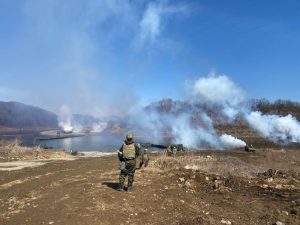North Korea fired two short-range ballistic missiles (SRBMs) toward its east coast, according to South Korea’s Joint Chiefs of Staff (JCS) on Tuesday. The missile launch came a day after the South Korea-U.S. regular springtime combined military drills kicked off and two days after the North conducted its first launch of cruise missiles from a submarine.
The two SRBMs were launched from the Jangyon area in South Hwanghae Province sometime between 7:41 a.m. to 7:51 a.m., according to the JCS. Based on the details released by the South’s military, it appears to be the first ballistic missile test conducted in Jangyon, located on the southwestern coast of the country. North Korea’s previous ballistic missile launch was carried out on March 9, when the North fired six SRBMs toward its western coast from the Nampo area.
The JCS said its military is maintaining full readiness through close coordination with the U.S. military. As the extensive Freedom Shield exercise with the U.S. military kicked off on Monday, the JCS also added that it is strengthening its surveillance and warning capabilities in order to cope with future North Korean missile launches during the drills. The drills will end on March 23.
In the lead-up to the South Korea-U.S. combined military exercises, North Korea vehemently threatened to take measures to respond to the drills. According to the North’s state media, Kim Jong Un, the autocratic leader of the North, presided over a meeting of the Central Military Commission of the Workers’ Party of Korea last week and discussed “important practical steps” for deterrence so as to cope with the rising tensions on the Korean Peninsula, which Pyongyang maintains are caused by South Korea and the United States. Although the “practical steps” were not outlined, the North seems to be willing to launch more ballistic missiles in the coming days, considering its missile tests so far this week.
Some experts expect that the North may scale up its future missile tests going forward, meaning it could test an intercontinental ballistic missile (ICBM) at a normal angle, which would mean overflight of North Korea’s neighbors. Previously, the North had launched its ICBM at a lofted angle, which has caused skepticism from some outside experts over its ICBM capabilities. Kim Jong Un’s sister, Kim Yo Jong, North Korea’s main voice on inter-Korea affairs, previously threatened to conduct an ICBM test at a “real angle” to counter those criticisms.
Col. Isaac L. Taylor, the spokesperson of the U.S. Forces Korea (USFK), said on March 3 that the Freedom Shield exercise is designed to strengthen the defense and response capabilities of the alliance against the North’s growing aggression.
“The DPRK’s unannounced cruise missile tests are yet another example of DPRK actions that threaten regional peace and stability,” Ned Price, the spokesperson of the U.S. State Department, said during the press briefing on Monday. (DPRK is an acronym of North Korea’s official name: Democratic People’s Republic of Korea.) “We remain focused on close coordination with our allies and partners to address the multitude of threats that’s posed by the DPRK, and to advance the shared objective that we put forward in the early months of this administration, namely the complete denuclearization of the Korean Peninsula.”
He added that North Korea’s actions have forced the U.S. and South Korea “to have to reinforce in tangible ways the security commitment that we have… We would much rather be engaging in dialogue and diplomacy.”
Stating that the North “has consistently posed a challenge to the rules-based order and to the vision of a free and open Indo-Pacific,” Price added that the United States. would take additional steps to clamp down on sanctions evasion, which contributes to the development of the North’s missile and nuclear programs. With this, he also urged China and Russia to help hold the North accountable for violating the U.N. Security Council resolutions.
While making clear the United States’ ceaseless effort to contain the North’s missile developments, Price reiterated that the U.S. administration is ready to engage in dialogue and diplomacy. However, he stated that it is Pyongyang that has rebuffed all offers of dialogue.

































